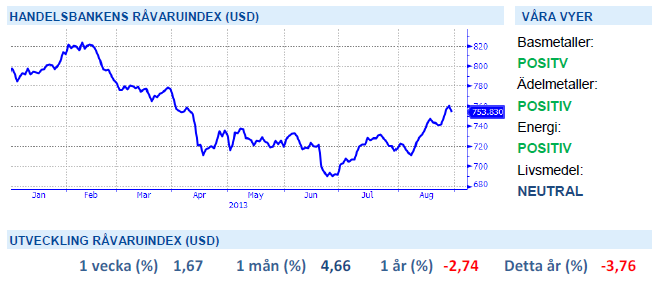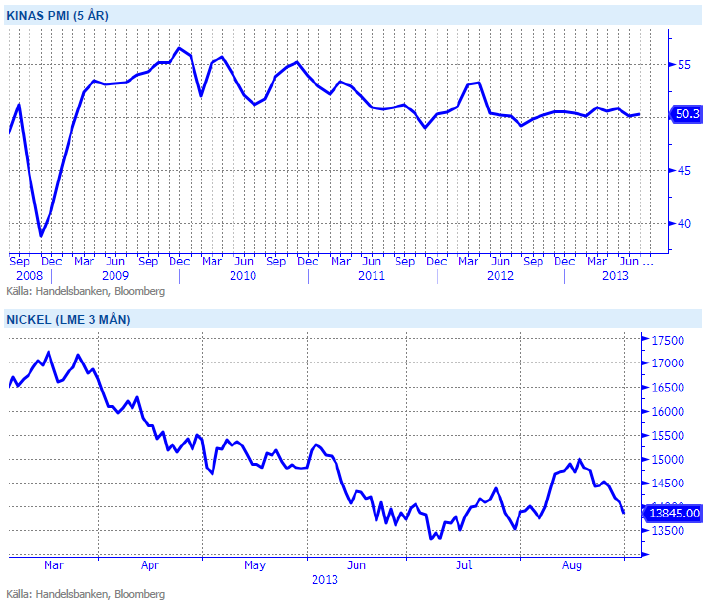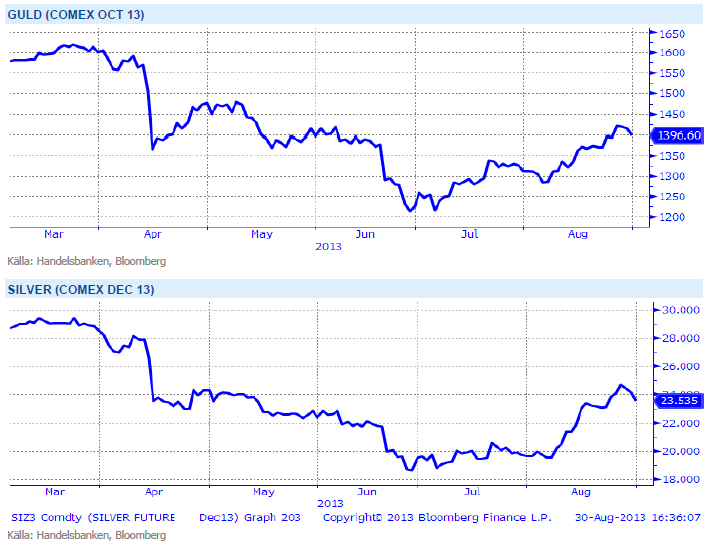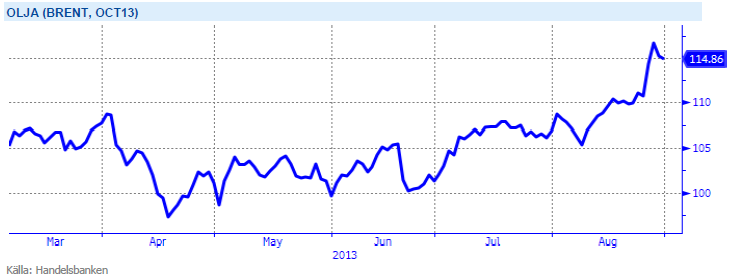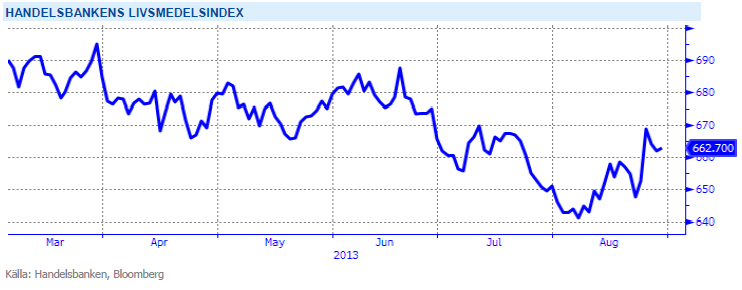Analys
SHB Råvarubrevet 30 augusti 2013

 Råvaror allmänt
Råvaror allmänt
Allt fokus på Syrien
USA tillsammans med Storbritannien och Frankrike laddar upp för någon slags militär intervention i syfte att straffa den syriska regimen för påstådda krigsförbrytelser, kanske i syfte att skicka en signal till andra länder att kemisk krigföring inte är acceptabelt. Detta har gett olja och guldpriset rejäl skjuts och bidragit till ökad volatilitet och sänkt riskaptit generellt på finansmarknaderna. Än så länge är det dock för tidigt att tala om några större negativa ekonomiska effekter från vad som hänt. Vad som händer framöver avgörs av vilka insatser som görs samt vilken respons det får, inte bara från Syriens regering utan även i omkringliggande länder och på ”den arabiska gatan”. Iraks oljeproduktion är den största riskfaktorn just nu. Den Sunni vs Shiite konflikt som råder i Syrien är direkt översättningsbar till Irak. Riskpremien i olja är därför motiverad då Irak, till skillnad från Syrien har en betydande oljeproduktion som Saudi inte kan täcka upp för.
Vårt positiva konjunkturscenario har getts stöd av den senaste statistiken, trots att amerikansk bostadsmarknadsdata på sistone överraskat något negativt. Risken för vissa ekonomiska bakslag senare i höst får sägas vara stigande givet att turbulensen i emerging markets i dagens marknad inte på något sätt tänks påverka varken Europa eller USA.
Basmetaller
I väntan på PMI från Kina
Basmetallerna har fallit något under veckan på den generella risk off rörelsen i bakvattnet av krigsrisken i Mellanöstern och som får industriella råvaror att backa medans klassiska krisindikator som guld och olja stiger. Vårt basmetallindex faller med 1,3 % där nickel återigen tar den största smällen, ner 4 %. Handelsdata, råvaruimport och flash PMI pekar all i rätt riktning för att Kinas makrodata ska kunna bli en otippad positiv överraskning under september.
På söndag publiceras Kinas PMI (det statliga) för augusti där förväntat 50,2 mot 50,3 i juli. HSBC:s PMI publiceras därefter på måndag där förväntat ligger på 50,2 mot 47,7 i juli. Vi räknar med positiv överraskning för dessa båda data vilket kommer driva basmetaller uppåt. Vi behåller vår positiva vy för basmetaller.
Nickel är den basmetall som gått ner mest under året och med många gruvor som går med förlust på dagens prisnivåer tror vi på stigande priser. Vi tror på: LONG NICKEL H
Ädelmetaller
Guld, fortsatt starkt, men platina ännu starkare
Guldet ligger i skrivande stund på samma nivå som förra veckan, 1395 dollar per uns. Förra veckan var det dock veckohögsta, denna veckan är det veckolägsta. Vi har varit uppe på 1430 dollar, drivet av John Kerrys uppskruvade retorik mot Syrien, men inga fundamentala nyheter har påverkat priset denna veckan. Vi tycker fortfarande att prisutvecklingen ser konstruktiv ut, och ligger kvar i vår positiva syn på guldet. Vi har haft 1450 som target i denna prisrörelse, och når vi dit så får vi ta en funderare på nästa steg.
I väntan på detta vill vi slå ett slag för en annan ädelmetall – platina – som inte bara får avsevärt mindre uppmärksamhet än guldet, utan också är något ”smartare” i betydelsen att den har en industriell nytta. Platina har faktiskt utpresterat guldet inte bara under guldets fall under våren, utan även under återhämtningen sedan halvårsskiftet. Vi har en positiv syn på hela ädelmetallsektorn, mest drivet av guldet, men kommer att titta lite närmare på platina framöver. Watch this space!
I ett läge där råvaror generellt har viktats ned av institutionella placerare kan guld och silver få en ”omotiverad” uppgång när dessa indexköpare återvänder till råvaror drivit av bättre utsikter för Kina och USA. Vi tror på: LONG GULD H och LONG SILVER H
Energi
Syrien pressar upp oljepriset
Brentoljan handlades upp på högsta nivån (USD 116.61) sedan februari efter oro kring ytterligare utbudsstörningar i Mellanöstern om västvärlden skulle intervenera i Syrien. Detta utöver rådande MENA oro och produktionsbortfall om ca 2.8 miljoner fat per dag under augusti främst från Iran och Libyen men även från Syrien, Sudan och Irak. Trenden förstärks ytterligare av globala tillväxtförväntningar. Ett ökat intresse för olja som aktiehedge skapar också momentum där marknaden blivit betydligt längre. Saudiarabien producerar närmare 10.5 miljoner fat per dag, den högsta nivån någonsin, vilket resulterar i en global reservkapacitet om endast 1.3 miljoner fat per dag vs USA:s skifferproduktion om 2.5 miljoner fat per dag. De globala utbudsstörningarna har ökat 3 miljoner fat per dag sedan december 2009 att jämföra med tillväxten i USA:s skifferproduktion om 2 miljoner fat per dag under samma period. Med kraftiga utbudsstörningar och låg reservkapacitet kan oljepriset med andra ord skjuta ordentligt i höjden vid en eventuell intervention i Syrien. Oavsett om det sker eller inte räknar vi med ett fortsatt högt oljepris med klar potential på uppsidan. Mer om utvecklingen på oljemarknaden.
Elmarknaden och kvartalet Q413 backar med strax över en procent efter att väderprognoserna tappat den torra avslutning som låg mot slutet av förra veckan. Nederbörden ser ut att gå mer mot normala nivåer vilket skulle innebära ett underskott kring ca 8-9 TWh efter vecka 36. Då gas får stöd av oljemarknaden samtidigt som utsläppsrätterna och kolet handlar oförändrat. Även om kolsentimentet försvagats något ytterligare i fronten, förväntar vi oss att elmarknaden handlar kvar i den range vi fastnat i med risken på uppsidan om vädret slår om mot det torrare slaget igen.
Oroligheterna i mellanöstern med risk för ytterligare produktionsbortfall ger stöd till oljepriset. Vi tror på: LONG OLJA
Livsmedel
Vädret i fokus
Vädret fortsätter att styra prisutvecklingen för vete, majs och sojabönor. Vete och majs steg i början av veckan men efter att regn (dock inga stora mängder) fallit över viktiga regioner i USA handlas grödorna nu på samma nivåer som måndagens öppning. Priset på sojabönor har rört sig sidledes under veckan och stänger något lägre (-1,4 %). Vi fortsätter att hålla neutral vy för denna sektor och konstaterar att väderprognoserna kommer stå i fokus ett tag framöver.
Det är fortfarande torrt vid Elfenbenskusten varför priset på kakao gått sidledes de senaste tre veckorna. Det var i början av augusti som priset på kakao steg 7 procent efter uteblivet regn. Västafrika står för 70 procent av den globala kakaoproduktionen och risken på uppsidan ökar i takt med fortsatt torka i dessa regioner. Kaffepriset fortsätter att backa och i skrivande stund handlas decemberkontraktet på 1,17 dollar/Ib. Årets skörd har hittills inte visat på några större överraskningar och det rapporteras om goda lager. Fler och fler odlare håller på sitt kaffe som följd av de låga kaffepriserna och hoppas på stigande priser.
Handelsbankens Råvaruindex
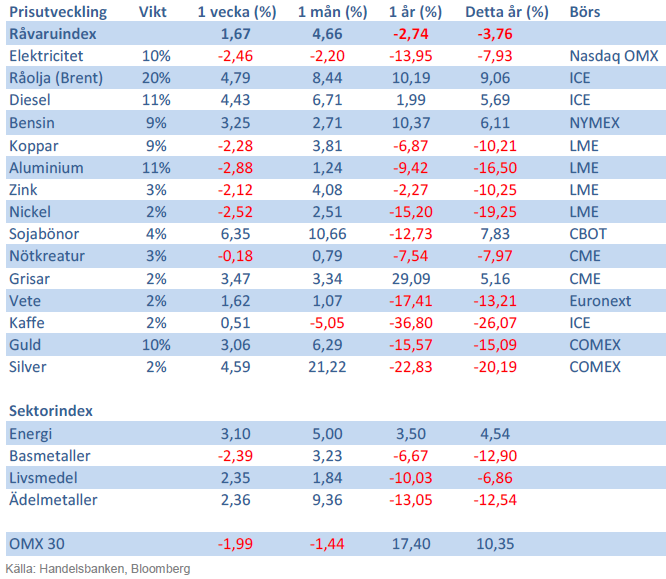
Handelsbankens råvaruindex består av de underliggande indexen för respektive råvara. Vikterna är bestämda till hälften från värdet av nordisk produktion (globala produktionen för sektorindex) och till hälften från likviditeten i terminskontrakten.
[box]SHB Råvarubrevet är producerat av Handelsbanken och publiceras i samarbete och med tillstånd på Råvarumarknaden.se[/box]
Ansvarsbegränsning
Detta material är producerat av Svenska Handelsbanken AB (publ) i fortsättningen kallad Handelsbanken. De som arbetar med innehållet är inte analytiker och materialet är inte oberoende investeringsanalys. Innehållet är uteslutande avsett för kunder i Sverige. Syftet är att ge en allmän information till Handelsbankens kunder och utgör inte ett personligt investeringsråd eller en personlig rekommendation. Informationen ska inte ensamt utgöra underlag för investeringsbeslut. Kunder bör inhämta råd från sina rådgivare och basera sina investeringsbeslut utifrån egen erfarenhet.
Informationen i materialet kan ändras och också avvika från de åsikter som uttrycks i oberoende investeringsanalyser från Handelsbanken. Informationen grundar sig på allmänt tillgänglig information och är hämtad från källor som bedöms som tillförlitliga, men riktigheten kan inte garanteras och informationen kan vara ofullständig eller nedkortad. Ingen del av förslaget får reproduceras eller distribueras till någon annan person utan att Handelsbanken dessförinnan lämnat sitt skriftliga medgivande. Handelsbanken ansvarar inte för att materialet används på ett sätt som strider mot förbudet mot vidarebefordran eller offentliggörs i strid med bankens regler.
Analys
Sell the rally. Trump has become predictable in his unpredictability

Hesitant today. Brent jumped to an intraday high of $66.36/b yesterday after having touched an intraday low of $60.07/b on Monday as Indian and Chinese buyers cancelled some Russian oil purchases and instead redirected their purchases towards the Middle East due to the news US sanctions. Brent is falling back 0.4% this morning to $65.8/b.

It’s our strong view that the only sensible thing is to sell this rally. In all Trump’s unpredictability he has become increasingly predictable. Again and again he has rumbled about how he is going to be tough on Putin. Punish Putin if he won’t agree to peace in Ukraine. Recent rumbling was about the Tomahawk rockets which Trump threatened on 10 October and 12 October to sell/send to Ukraine. Then on 17 October he said that ”the U.S. didn’t want to give away weapons (Tomahawks) it needs”.
All of Trump’s threats towards Putin have been hot air. So far Trump’s threats have been all hot air and threats which later have evaporated after ”great talks with Putin”. After all these repetitions it is very hard to believe that this time will be any different. The new sanctions won’t take effect before 21. November. Trump has already said that: ”he was hoping that these new sanctions would be very short-lived in any case”. Come 21. November these new sanctions will either evaporate like all the other threats Trump has thrown at Putin before fading them. Or the sanctions will be postponed by another 4 weeks or 8 weeks with the appearance that Trump is even more angry with Putin. But so far Trump has done nothing that hurt Putin/Russia. We can’t imagine that this will be different. The only way forward in our view for a propre lasting peace in Ukraine is to turn Ukraine into defensive porcupine equipped with a stinging tail if need be.
China will likely stand up to Trump if new sanctions really materialize on 21 Nov. Just one country has really stood up to Trump in his tariff trade war this year: China. China has come of age and strength. I will no longer be bullied. Trump upped tariffs. China responded in kind. Trump cut China off from high-end computer chips. China put on the breaks on rare earth metals. China won’t be bullied any more and it has the power to stand up. Some Chinese state-owned companies like Sinopec have cancelled some of their Russian purchases. But China’s Foreign Ministry spokesperson Guo Jiakun has stated that China “oppose unilateral sanctions which lack a basis in international law and authorization of the UN Security Council”. Thus no one, not even the US shall unilaterally dictate China from whom they can buy oil or not. This is yet another opportunity for China to show its new strength and stand up to Trump in a show of force. Exactly how China choses to play this remains to be seen. But China won’t be bullied by over something as important as its oil purchases. So best guess here is that China will defy Trump on this. But probably China won’t need to make a bid deal over this. Firstly because these new sanctions will either evaporate as all the other threats or be postponed once we get to 21 November. Secondly because the sanctions are explicit towards US persons and companies but only ”may” be enforced versus non-US entities.
Sanctions is not a reduction in global supply of oil. Just some added layer of friction. Anyhow, the new sanctions won’t reduce the supply of Russian crude oil to the market. It will only increase the friction in the market with yet more need for the shadow fleet and ship to ship transfer of Russian oil to dodge the sanctions. If they materialize at all.
The jump in crude oil prices is probably due to redirections of crude purchases to the Mid-East and not because all speculators are now turned bullish. Has oil rallied because all speculators now suddenly have turned bullish? We don’t think so. Brent crude has probably jumped because some Indian and Chinese oil purchasers of have redirected their purchases from Russia towards the Mid-East just in case the sanctions really materializes on 21 November.
Analys
Brent crude set to dip its feet into the high $50ies/b this week

Parts of the Brent crude curve dipping into the high $50ies/b. Brent crude fell 2.3% over the week to Friday. It closed the week at $61.29/b, a slight gain on the day, but also traded to a low of $60.14/b that same day and just barely avoided trading into the $50ies/b. This morning it is risk-on in equities which seems to help industrial metals a little higher. But no such luck for oil. It is down 0.8% at $60.8/b. This week looks set for Brent crude to dip its feet in the $50ies/b. The Brent 3mth contract actually traded into the high $50ies/b on Friday.

The front-end backwardation has been on a weakening foot and is now about to fully disappear. The lowest point of the crude oil curve has also moved steadily lower and lower and its discount to the 5yr contract is now $6.8/b. A solid contango. The Brent 3mth contract did actually dip into the $50ies/b intraday on Friday when it traded to a low point of $59.93/b.
More weakness to come as lots of oil at sea comes to ports. Mid-East OPEC countries have boosted exports along with lower post summer consumption and higher production. The result is highly visibly in oil at sea which increased by 17 mb to 1,311 mb over the week to Sunday. Up 185 mb since mid-August. On its way to discharge at a port somewhere over the coming month or two.
Don’t forget that the oil market path ahead is all down to OPEC+. Remember that what is playing out in the oil market now is all by design by OPEC+. The group has decided that the unwind of the voluntary cuts is what it wants to do. In a combination of meeting demand from consumers as well as taking back market share. But we need to remember that how this plays out going forward is all at the mercy of what OPEC+ decides to do. It will halt the unwinding at some point. It will revert to cuts instead of unwind at some point.
A few months with Brent at $55/b and 40-50 US shale oil rigs kicked out may be what is needed. We think OPEC+ needs to see the exit of another 40-50 drilling rigs in the US shale oil patches to set US shale oil production on a path to of a 1 mb/d year on year decline Dec-25 to Dec-26. We are not there yet. But a 2-3 months period with Brent crude averaging $55/b would probably do it.
Oil on water increased 17 mb over the week to Sunday while oil in transit increased by 23 mb. So less oil was standing still. More was moving.

Crude oil floating storage (stationary more than 7 days). Down 11 mb over week to Sunday

The lowest point of the Brent crude oil curve versus the 5yr contract. Weakest so far this year.

Crude oil 1mth to 3mth time-spreads. Dubai held out strongly through summer, but then that center of strength fell apart in late September and has been leading weakness in crude curves lower since then.

Analys
Crude oil soon coming to a port near you

Rebounding along with most markets. But concerns over solidity of Gaza peace may also contribute. Brent crude fell 0.8% yesterday to $61.91/b and its lowest close since May this year. This morning it is bouncing up 0.9% to $62.5/b along with a softer USD amid positive sentiment with both equities and industrial metals moving higher. Concerns that the peace in Gaza may be less solid than what one might hope for also yields some support to Brent. Bets on tech stocks are rebounding, defying fears of trade war. Money moving back into markets. Gold continues upwards its strong trend and a softer dollar helps it higher today as well.

US crude & products probably rose 5.6 mb last week (API) versus a normal seasonal decline of 2.4 mb. The US API last night partial and thus indicative data for US oil inventories. Their data indicates that US crude stocks rose 7.4 mb last week, gasoline stocks rose 3.0 mb while Distillate stocks fell 4.8 mb. Altogether an increase in commercial crude and product stocks of 5.6 mb. Commercial US crude and product stocks normally decline by 2.4 mb this time of year. So seasonally adjusted the US inventories rose 8 mb last week according to the indicative numbers by the API. That is a lot. Also, the counter seasonal trend of rising stocks versus normally declining stocks this time of year looks on a solid pace of continuation. If the API is correct then total US crude and product stocks would stand 41 mb higher than one year ago and 6 mb higher than the 2015-19 average. And if we combine this with our knowledge of a sharp increase in production and exports by OPEC(+) and a large increase in oil at sea, then the current trend in US oil inventories looks set to continue. So higher stocks and lower crude oil prices until OPEC(+) switch to cuts. Actual US oil inventory data today at 18:00 CET.
US commercial crude and product stocks rising to 1293 mb in week 41 if last nights indicative numbers from API are correct.

Crude oil soon coming to a port near you. OPEC has lifted production sharply higher this autumn. At the same time demand for oil in the Middle-East has fallen as we have moved out of summer heat and crude oil burn for power for air-conditioning. The Middle-East oil producers have thus been able to lift exports higher on both accounts. Crude oil and condensates on water has shot up by 177 mb since mid-August. This oil is now on its way to ports around the world. And when they arrive, it will likely help to lift stocks onshore higher. That is probably when we will lose the last bit of front-end backwardation the the crude oil curves. That will help to drive the front-month Brent crude oil price down to the $60/b line and revisit the high $50ies/b. Then the eyes will be all back on OPEC+ when they meet in early November and then again in early December.
Crude oil and condensates at sea have moved straight up by 177 mb since mid-August as OPEC(+) has produced more, consumed less and exported more.

-

 Nyheter4 veckor sedan
Nyheter4 veckor sedanOPEC+ missar produktionsmål, stöder oljepriserna
-

 Nyheter2 veckor sedan
Nyheter2 veckor sedanGoldman Sachs höjer prognosen för guld, tror priset når 4900 USD
-

 Nyheter3 veckor sedan
Nyheter3 veckor sedanBlykalla och amerikanska Oklo inleder ett samarbete
-

 Nyheter3 veckor sedan
Nyheter3 veckor sedanGuld nära 4000 USD och silver 50 USD, därför kan de fortsätta stiga
-

 Analys4 veckor sedan
Analys4 veckor sedanAre Ukraine’s attacks on Russian energy infrastructure working?
-

 Nyheter2 veckor sedan
Nyheter2 veckor sedanLeading Edge Materials är på rätt plats i rätt tid
-

 Nyheter2 veckor sedan
Nyheter2 veckor sedanNytt prisrekord, guld stiger över 4000 USD
-

 Nyheter3 veckor sedan
Nyheter3 veckor sedanEtt samtal om guld, olja, koppar och stål


